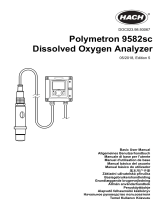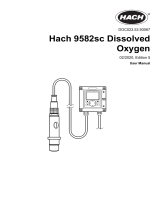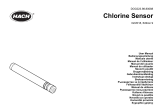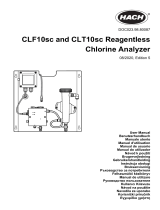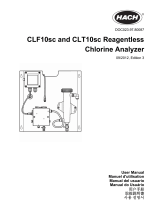Page is loading ...

Reference Manual
00809-0100-3414, Rev AA
May 2019
Rosemount
™
MCL-220
Monochloramine System with Rosemount 1056 Transmitter

Essential instructions
Read this page before proceeding!
Your instrument purchase from Emerson is one of the finest available for your particular application. These instruments have been
designed and tested to meet many national and international standards. Experience indicates that its performance is directly
related to the quailty of the installation and knowledge of the user in operating and maintaining the instrument. To ensure
continued operation to the design specifications, read this Manual thoroughly before proceeding with installation,
commissioning, operation, and maintenance of this instrument. If this equipment is used in a manner not specified by the
manufacturer, the protection provided by it against hazards may be impaired.
• Failure to follow the proper instructions may cause any one of the following situations to occur: loss of life, personal injury,
property damage, damage to this instrument, and warranty invalidation.
• Ensure that you have received the correct model and options from your purchase order. Verify that this Manual covers your
model and options. If not, call 1-800-999-9307 to request the corrrect Manual.
• For clarification of instructions, contact your Rosemount
™
representative.
• Follow all warnings, cautions, and instructions marked on and supplied with the product.
• Use only qualified personnel to install, operate, program, and maintain the product.
• Install equipment as specified in the installation section of this Manual. Follow appropriate local and national codes. Only
connect the product to electrical and pressure sources specified in this Manual.
• Use only factory documented components for repair. Tampering or unauthorized substitution of parts and procedures can
affect the performance and cause unsafe operation of your process.
• All equipment doors must be closed, and protective covers must be in place unless qualified personnel are performing
maintenance.
• If this equipment is used in a manner not specified by the manufacturer, the protection provided by it against hazards may be
impaired.
Note
Risk of electrical shock
Installing cable connections and servicing this product may require access to shock and high voltage levels.
Equipment protected throughout by double insulation.
Disconnect main power wired to separate power source before servicing.
Do not operate or energize instrument with case open.
Signal wiring within this box must be rated at least 240 V.
Non-metallic cable strain reliefs do not provide grounding between conduit connections. Use grounding type bushings
and jumper wires.
Unused cable conduit entries must be securely sealed by non-flammable closures to provide exposure integrity in
compliance with personal safety and environmental protection requirements. Unused conduit openings must be sealed
with NEMA 4X or IP65 conduit plugs to maintain the ingress protection rating (IP65).
Electrical installation must be in accordance with the National Electrical Code (ANSI/NFPA-70) and/or any other national
or local codes.
Operate only with front and rear panels fastened and in place over terminal area.
Safety and performance require that this instrument be connected and properly grounded through a three-wire power
source.
This product is not intended for use in the light industrial, residential, or commercial environments per the instrument's
certification to EN50081-2.
2

Note
Radio interference
This product generates, uses, and can radiate radio frequency energy and thus can cause radio communication interference.
Improper installation or operation may increase such interference. As temporarily permitted by regulation, this unit has not
been tested for compliance within the limits of Class A computing devices, pursuant to Subpart J of Part 15 of FCC rules,
which are designed to provide reasonable protection against such interference.
Operation of this equipment in a residential area may cause interference, in which case the operator, at his own
expense, will be required to take whatever measures may be required to correct the interference.
WARNING
Physical access
Unauthorized personnel may potentially cause significant damage to and/or misconfiguration of end users’ equipment. This
could be intentional or unintentional and needs to be protected against.
Physical security is an important part of any security program and fundamental to protecting your system. Restrict physical
access by unauthorized personnel to protect end users’ assets. This is true for all systems used within the facility.
3

4

Contents
Chapter 1 Quick Start.....................................................................................................................7
Chapter 2 Description and specifications......................................................................................11
2.1 Specifications................................................................................................................................. 11
2.2 Ordering information..................................................................................................................... 12
Chapter 3 Install...........................................................................................................................13
3.1 Unpack and inspect........................................................................................................................ 13
3.2 Rosemount MCL-220......................................................................................................................13
3.3 General installation information..................................................................................................... 13
3.4 Sample requirements..................................................................................................................... 14
3.5 Mounting, inlet, and drain connections.......................................................................................... 14
3.6 Install the sensor............................................................................................................................ 15
Chapter 4 Wire............................................................................................................................ 17
4.1 Wire power.....................................................................................................................................17
4.2 Wire analog outputs.......................................................................................................................17
4.3 Alarm wiring...................................................................................................................................18
4.4 Wire sensor.................................................................................................................................... 20
Chapter 5 Display and operation.................................................................................................. 23
5.1 Display........................................................................................................................................... 23
5.2 Keypad........................................................................................................................................... 24
5.3 Program the transmitter.................................................................................................................26
5.4 Security.......................................................................................................................................... 28
5.5 Using hold...................................................................................................................................... 29
5.6 Configure the main display.............................................................................................................30
Chapter 6 Programming the transmitter......................................................................................33
6.1 Programming overview.................................................................................................................. 33
6.2 Default settings.............................................................................................................................. 33
6.3 Configuring, ranging, and simulating outputs................................................................................ 35
6.4 Configuring alarms and assigning setpoints....................................................................................39
6.5 Configuring the measurement....................................................................................................... 46
6.6 Configuring temperature related settings...................................................................................... 47
6.7 Configuring security settings..........................................................................................................49
6.8 Resetting the transmitter............................................................................................................... 51
Chapter 7 Calibrate...................................................................................................................... 53
7.1 Introduction................................................................................................................................... 53
7.2 Calibrating temperature.................................................................................................................53
7.3 Calibrating monochloramine..........................................................................................................55
7.4 Calibration - analog outputs........................................................................................................... 60
Reference Manual Contents
00809-0100-3414 May 2019
Rosemount MCL v

Chapter 8 Maintenance................................................................................................................63
8.1 Replace sensor circuit board........................................................................................................... 63
8.2 Monochloramine sensor.................................................................................................................64
8.3 Constant head flow controller........................................................................................................ 66
Chapter 9 Troubleshoot............................................................................................................... 69
9.1 Overview........................................................................................................................................ 69
9.2 Use the diagnostic feature..............................................................................................................69
9.3 Troubleshooting when a Fault message is showing.........................................................................70
9.4 Troubleshooting when a Warning message is showing...................................................................74
9.5 Troubleshooting when no error message is showing...................................................................... 75
9.6 Troubleshooting when no error message is showing - general........................................................79
9.7 Simulate inputs.............................................................................................................................. 80
9.8 Simulating temperature................................................................................................................. 81
Appendix A EU Declaration of Conformity....................................................................................... 85
Appendix B China RoHS Table......................................................................................................... 87
Contents Reference Manual
May 2019 00809-0100-3414
vi Emerson.com/Rosemount

1 Quick Start
Procedure
1. Once connections are secured and verified, apply power to the transmitter.
When the transmitter is powered up for the first time, Quick Start screens appear.
Using Quick Start is easy.
a. A backlit field shows the position of the cursor.
b. To move the cursor left or right, use the keys to the left or right of the ENTER
key. To scroll up or down or to increase or decrease the value of a digit, use
the keys above and below the ENTER key. Use the left and right keys to move
the decimal point.
c. Press ENTER to store a setting. Press EXIT to leave without storing changes.
Pressing EXIT also returns the display to the initial Quick Start screen.
d. A vertical black bar with a downward pointing arrow on the right side of the
screen means there are more items to display. Continue scrolling down to
display all the items. When you reach the bottom of the list, the arrow points
up.
2. Choose the desired language. Scroll down to display more choices.
3. Choose Monochloramine for sensor 1 (S1).
4. Choose the desired units for chlorine.
Reference Manual Quick Start
00809-0100-3414 May 2019
Rosemount MCL 7

5. Choose the desired temperature units.
The main display appears. The outputs and alarms (if an alarm board is present) are
assigned to default values.
6. To change outputs, alarms, and other settings, go to the Main Menu and choose
Program. Follow the prompts.
Quick Start Reference Manual
May 2019 00809-0100-3414
8 Emerson.com/Rosemount

Reference Manual Quick Start
00809-0100-3414 May 2019
Rosemount MCL 9

Quick Start Reference Manual
May 2019 00809-0100-3414
10 Emerson.com/Rosemount

2 Description and specifications
2.1 Specifications
Rosemount
™
1056 Transmitter
For Rosemount 1056 Transmitter specifications, see the Rosemount 1056 Transmitter
Reference Manual on Emerson.com/Rosemount: Manual: Rosemount 1056 Dual-Input
Transmitter.
Table 2-1: General Specifications
Characteristic Specification
Sample requirements • Pressure: 3 to 65 psig (122 to 549 kPa abs). A
check valve in the inlet prevents the sensor
flow cells from going dry if sample flow is
lost. The check valve opens at 3 psig (122
kPa abs). If the check valve is removed,
minimum pressure is 1 psig (108 kPa abs).
• Temperature: 32 to 122 °F (0 to 50 °C)
• Minimum flow: 3 gal/hr (11 L/hr)
• Maximum flow: 80 gal/hr (303 L/hr); high
flow causes the overflow tube to back up.
Sample conductivity >10 µS/cm at 77 °F (25 °C)
Process connection ¼-in. OD tubing compression fitting (can be
removed and replaced with barbed fitting for
soft tubing)
Drain connection ¾-in. barbed fitting. Sample must drain to open
atmosphere.
Wetted parts Overflow sampler: acrylic, nylon, polycarbonate,
polyester, and silicone
Monochloramine sensor: Noryl
®
, Viton
®
,
silicone, and Zitex
®
. PFTE gold mesh cathode
(not normally wetted).
Response time to step change in
monochloramine concentration
<60 sec to 95% of final reading for inlet sample
flow of 17 gph (64 L/hr)
Weight/shipping weight (rounded to the
nearest 1 lb. or 0.5 kg)
10 lb./13 lb. (4.5 kg/6.0 kg)
Table 2-2: Sensor Specifications
Characteristic Specification
Range 0 to 6 ppm as Cl
2
. For higher ranges, consult the
factory.
Reference Manual Description and specifications
00809-0100-3414 May 2019
Rosemount MCL 11

Table 2-2: Sensor Specifications (continued)
Characteristic Specification
pH range Response is practically independent of pH
between pH 7.0 and 10.0. Sensor current at pH
10.0 is within 5% of sensor current at pH 7.0.
Accuracy Accuracy depends on the accuracy of the
chemical test used to calibrate the sensor.
Linearity 2% (typ.)
Electrolyte volume 25 mL (approx.)
Electrolyte life 2 months (approx.)
2.2 Ordering information
The Rosemount MCL-220 is a complete system for the determination of monochloramine
in water. It consists of a monochloramine sensor, Rosemount 1056 transmitter, Variopol
cable, and constant head overflow cup to control sample flow. All components are
mounted on a backplate, and the cable is pre-wired to the transmitter. Three replacement
membranes and a 4-oz bottle of electrolyte solution are shipped with the sensor.
Table 2-3: Component Parts
Transmitter model Description
1056-03-24-38-AN Rosemount 1056 transmitter, single input
(monochloramine), alarm relays, analog output,
115/230 Vac
Sensor model Description
499ACL-03-54-VP Monochloramine sensor with Variopol connector
Sensor cable Description
23747-04 Interconnecting cable, Variopol for Rosemount
499ACL sensor, 4 ft
Table 2-4: Accessories
Part number Description
9240048-00 Tag, stainless steel (specify marking)
Description and specifications Reference Manual
May 2019 00809-0100-3414
12 Emerson.com/Rosemount

3 Install
3.1 Unpack and inspect
Procedure
1. Inspect the shipping container(s). If there is damage, contact the shipper
immediately for instructions.
2. If there is no apparent damage, unpack the container(s).
3. Ensure that all items shown on the packing list are present.
If items are missing, notify Emerson immediately.
3.2 Rosemount MCL-220
The Rosemount MCL-220 consists of the following items mounted on a back plate.
1. The Rosemount 1056-03-24-38-AN with sensor cable attached.
2. Constant head overflow sampler with flow cell for monochloramine sensor.
3. The monochloramine sensor (Rosemount 499ACL-03-54-VP), three membrane
assemblies, and a bottle of electrolyte solution are in a separate package.
3.3 General installation information
1. Although the system is suitable for outdoor use, do not install it in direct sunlight or
in areas of extreme temperature.
CAUTION
Hazardous areas
The system is not suitable for use in hazardous areas.
2. To keep the transmitter enclosure watertight, install plugs (provided) in the unused
conduit openings.
3. Install the system in an area where vibrations and electromagnetic and radio
frequency interference are minimized or absent.
4. Keep the transmittter and sensor wiring at least one foot from high voltage
conductors. Be sure there is easy access to the transmitter and sample conditioning
system.
5. Be sure there is easy access to the transmitter and sensor(s).
Reference Manual
Install
00809-0100-3414 May 2019
Rosemount MCL 13

3.4 Sample requirements
Be sure the sample meets the following requirements:
1. Temperature: 32 to 122 °F (0 to 50 °C )
2. Pressure: 3 to 65 psig (122 to 549 kPa abs)
3.
3.5 Mounting, inlet, and drain connections
The Rosemount
™
MCL-220 is intended for wall mounting only.
Refer to Figure 3-1 for details. The sensor screws into the flow cell adapter.
Figure 3-1: Rosemount MCL-220 Monochloramine System
A. Chlorine sensor
B. Check valve
C. Inlet
D. Drain
If desired, you can remove the compression fitting and replace it with a barb fitting. The
inlet fitting screws into a ¼-in. FNPT check valve. The check valve prevents the sensor flow
cell from going dry if sample flow is lost.
Install
Reference Manual
May 2019 00809-0100-3414
14 Emerson.com/Rosemount

1. Attach a piece of soft tubing to the fitting and allow the waste to drain to open
atmosphere.
Important
Do not restrict the drain line.
2. Remove the foam packing insert between the outer tube and the inner overflow
tube.
3. Adjust the sample flow until the water level is even with the central overflow tube
and excess water is flowing down the tube.
3.6 Install the sensor
Emerson provides the Rosemount
™
MCL with the sensor cable pre-wired to the
transmitter. The terminal end of the sensor is keyed to ensure proper mating with the
cable receptacle.
Procedure
1. Once the key has slid into the mating slot, tighten the connection by turning the
knurled ring clockwise.
2. Screw the sensor into a plastic fitting, which is held in the flow cell by a union nut.
Do not remove the protective cap on the sensor until ready to put the sensor in
service.
Reference Manual Install
00809-0100-3414 May 2019
Rosemount MCL 15

Install Reference Manual
May 2019 00809-0100-3414
16 Emerson.com/Rosemount

4 Wire
4.1 Wire power
Wire AC mains power supply to the power supply board, which is mounted vertically on
the left hand side of the transmitter enclosure.
WARNING
Electrical shock
Electrical installation must be in accordance with the National Electrical Code (ANSI/
NFPA-70) and/or any other applicable national or local codes.
The power connector is at the top of the board.
Procedure
1. Unplug the connector from the board and wire the power cable to it.
Lead connections are marked on the connector. (L is live or hot; N is neutral; the
ground connection has the standard symbol.)
2. Provide a switch or breaker to disconnect the transmitter from the main power
supply.
3. Install the switch or breaker near the transmitter and label it as the disconnecting
device for the transmitter.
4.2 Wire analog outputs
Two analog output currents are located on the main circuit board, which is attached to the
inside of the enclosure door.
Figure 4-1 shows the locations of the terminals. The connectors can be detached for
wiring. TB-1 is output 1. TB-2 is output 2. Polarity is marked on the circuit board.
Reference Manual Wire
00809-0100-3414 May 2019
Rosemount MCL 17

Figure 4-1: Analog output connections
The analog outputs are on the main board near the hinged end of the enclosure door.
For best EMI/RFI protection, use shielded output signal cable enclosed in earth-grounded
metal conduit.
Keep output signal wiring separate from power wiring. Do not run signal and power or
relay wiring in the same conduit or close together in a cable tray.
4.3 Alarm wiring
The alarm relay terminal strip is located just below the power connector on the power
supply board.
See Figure 4-2.
Wire
Reference Manual
May 2019 00809-0100-3414
18 Emerson.com/Rosemount

Figure 4-2: Alarm relay connections
A. Alarm relay 1
B. Alarm relay 2
C. Alarm relay 3
D. Alarm relay 4
1. To remove the cover, grab it by the upper edges and pull straight out. The relay
terminal strip is at the top of the board.
2. Bring the relay wires through the rear conduit opening on the left hand side of the
enclosure and make connections to the terminals strip.
3. Replace the cover. The two tabs on the back edge of the cover fit into slots at the
rear of the enclosure, and the three small slots in the front of the cover snap into the
three tabs next to the relay terminal strip. See Figure 4-2. Once the tabs are lined
up, push the cover to snap it in place.
Keep alarm relay wiring separate from signal wiring. Do not run signal and power or relay
wiring in the same conduit or close together in a cable tray.
Reference Manual Wire
00809-0100-3414 May 2019
Rosemount MCL 19

4.4 Wire sensor
The Rosemount
™
MCL is provided with sensor cables pre-wired to the transmitter. If it is
necessary to replace the sensor cable, refer to the instructions below.
Procedure
1. Shut off power to the transmitter.
2. Loosen the four screws holding the front panel in place and let it drop down.
3. Locate the appropriate signal board.
Slot 1 (left) Slot 2 (center)
communication input 1 (chlorine)
Slot 1 (left) Slot 2 (center) Slot 3 (right)
communication input 1 (chlorine) input 2 (optional)
4. Loosen the gland fitting and carefully push the sensor cable up through the fitting
as you pull the board forward to gain access to the wires and terminal screws.
5. Disconnect the wires and remove the cable.
6. Insert the new cable through the gland and pull the cable through the cable slot.
7. Wire the sensor to the signal board.
See Figure 4-3.
Wire Reference Manual
May 2019 00809-0100-3414
20 Emerson.com/Rosemount
/
